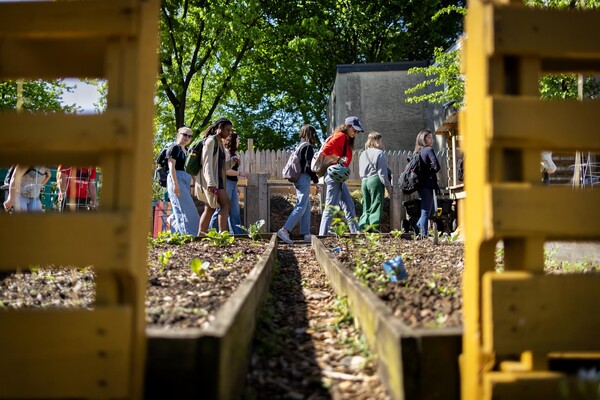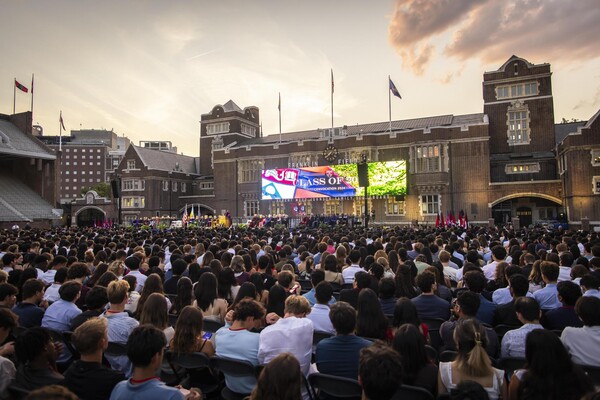Penn’s own environmental force of nature talks about preparing the next generation to save the planet
Included in this special report:
Penn’s own environmental force of nature talks about preparing the next generation to save the planet
Cultivating a “green” culture
Alum, professor helping turn former railway into urban promenade
MES program designed to turn out ‘pioneering, adventurous students’
Morris horticulturalist works to save Wissahickon, wetland
Home to the oldest geology department in the Western Hemisphere, Penn has a long history in the earth sciences. It wasn’t until 1970, though, on the heels of the first Earth Day, that the University launched an undergraduate major in environmental studies. Thirty years later, Bob Giegengack, the earth and environmental science professor who got the program up and running, reflects on how the major, and environmentalism, has evolved.
Q. What are the basic building blocks of the major?
A. The introductory course is an overview of how the world works normally. If you’re going to worry about environmental perturbation and intervention it’s essential to learn as much as you can about how those systems worked before we started mucking them up. And that’s hard to do because we didn’t start to look at them until they were already mucked up. The second course is a case studies course where we introduce the students to examples of environmental perturbation. We also require they do a concentration in some other discipline. And we’ve had them all, including everything from physics to folklore, fine arts to religion.
Q. Is travel an important component?
A. It is to us. It’s not to every environmental program. A lot of them are strongly policy focused, but to us it’s important. Everyone in the department is a field scientist of one kind or another.
Q. How do the students respond to fieldwork?
A. Not all of them like it. It’s not the shock of a different geological environment—the kids who are attracted to geology are a pretty outdoorsy lot to start with, so the rigors of living in the field are rarely a challenge—it’s the culture shock that’s so dramatic.
Q. Students also get involved locally in lead abatement. Tell me about that.
A: We teach the Penn kids about lead and we send them into the schools to teach the school kids about lead. We deputize the schoolchildren to go into their homes and neighborhoods and collect samples of paint off the wall and dirt from the curb. They bring them back and we analyze them here for lead. Then the Penn kids send the numbers back to school and the kids plot out the neighborhood lead values and draft detailed brochures helping families protect young children. I love to take a suburban kid and put them into Shaw Middle School. They’re appalled by the chaos in the classroom. After a couple of visits they realize they’re just great kids.
Q. How have the “big issues” of environmentalism changed over the last 30 years?
A. The issues are basically the same, though there wasn’t the general hysteria about global warming that prevails today. In 1970 we were still in a period of global cooling. People were aware that the release of industrial gases into the atmosphere would lead ultimately to warming but it wasn’t actually taking place so it was hard to make a case for that. Air and water quality were big issues, and of course they still are, but there wasn’t the focus on loss of habitat and loss of biodiversity.
Q. What environmental issues should we be most concerned about?
A. We’re five percent of the world’s population and we use 25 percent of its energy. We need a major overhaul of the way we use energy. Americans use twice as much as the British, and life is OK in England. There’s a strong case to be made that any individual’s impact on the environment is in direct proportion to his or her energy use, so we’re hurting the environment more per capita than almost anyone else. Canadians are doing it a little bit more, but it is cold up there. And a few other countries in the Persian Gulf have higher per capita expenditures but that’s because they’re using a lot of energy to make energy for the rest of us.
Q. Is it as bad as we think?
A. When I talk about global warming I try to put it in the context of where the climate’s been for the last million years. And actually the present is extraordinary in the fact that it’s so cold. Earth scientists have a long-term perspective, and that’s an important message to give our students. Our government can’t embrace that perspective because it won’t get them elected.
Q. What do you say to people who drive Hummers?
A. If you go through the calculations I think you can show that the fuel use of a vehicle is a small amount of its total energy consumption—the energy cost of making it and delivering it is very substantial. I think we should look not so much at mileage but at life expectancy. So if I had to make a decision about the least destructive car, I’d probably pick a small, cheap, durable Toyota.








